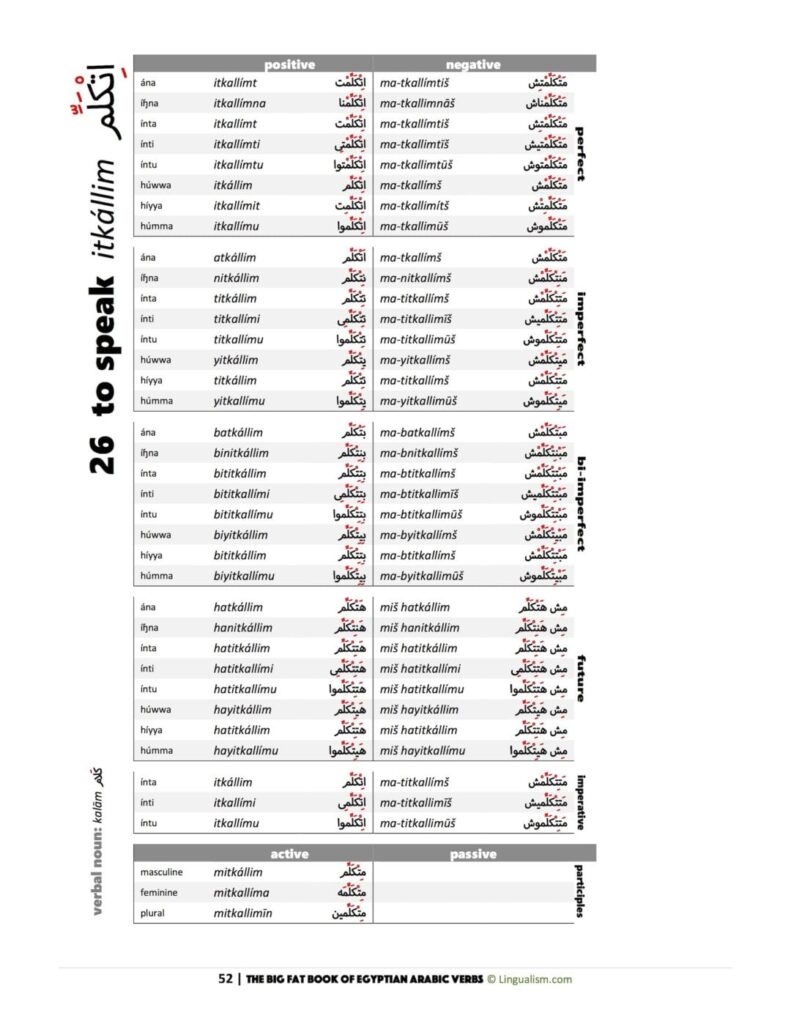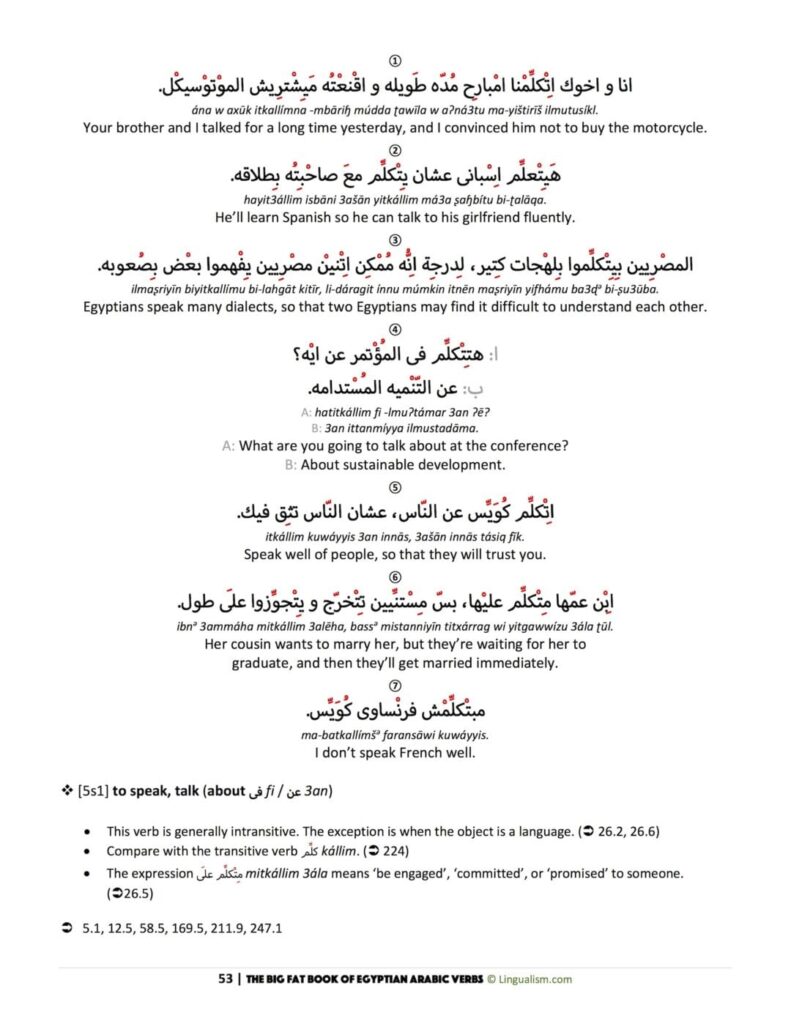The Big Fat Book of Egyptian Arabic Verbs is not an introduction to Egyptian Colloquial Arabic (ECA) verbs. In order to best make use of this book, you should have some Arabic under your belt, whether that be ECA or Modern Standard Arabic (MSA). It is assumed that you already have at least a basic understanding of verb conjugation in Arabic and the use of tenses. But fear not, very brief reviews are provided in the book’s glossary section. A review of the sounds of ECA and the phonemic transcription is found in the pronunciation section. For more in-depth coverage of verb tenses, see Lingualism’s book Egyptian Colloquial Arabic Verbs: Conjugation Tables and Grammar, which lays out the system by which all ECA verbs can be grouped.
This book contains 264 ‘key’ verbs, numbered for easy reference. They are ordered alphabetically according to the Arabic script, with the exception of the first two tables. Verb 1 is كان kān ‘be’, which is arguably the most important and common verb in Arabic and is used to form compound tenses. Verb 2 is actually not a verb at all, but three common structures which are used with the verb كان kān ‘be’ and translate ‘have’.
Next to each verb’s number (on the left margin of the pages with verb tables), you will see the base form of the Arabic verb (that is, the masculine third-person singular perfect tense form) with a common English translation. A verb often has many possible translations, and these are given after the examples on the right-facing page.
THE CONJUGATION TABLES

Let’s take a look at one of the conjugation tables in this book as you read about its organization:
In Egyptian Arabic, there are eight persons (labeled on the left side of each table) and therefore eight conjugations for each tense of a verb. (Strictly speaking, some of these should be called moods, not tenses, but for simplicity’s sake, we’ll call them all tenses.) The four tenses of ECA are the perfect, the (bare) imperfect, the bi-imperfect, and the future.
You will see each of these labels along the right side of each table. The four tenses and the imperative have both positive and negative forms. The positive forms are listed on the left half of the table, while the negative forms are on the right. At the bottom of the table, you can see the participle forms. Not all verbs have both active and passive participles. Finally, on the left edge of the table, you will see the verbal noun(s).
EXAMPLES AND NOTES
Several example sentences are given on the page following each table. (In the print book available on Amazon, this is the right-facing page.) Each example is numbered for easy reference. Try to find the key verb in each example and match it to its place on the conjugation table. Notice if the verb’s pronunciation is affected by neighboring words or suffixes. Take time to analyze the sentence and notice how the verb is used in relation to other words. Does it take a direct object? Is it followed by a preposition? Does it seem to have just one meaning or several distinct meanings? Can you spot collocations? Some of these questions will be answered for you in the notes.

Below the example sentences, you will see English translations for the verb. Synonyms are separated by commas, while different meanings are separated by semicolons. If a verb requires a preposition before its object, you will also see this here in parentheses. (Note that a verb may require a preposition in one meaning but not in another.)
Preceding the translations, you will see square brackets. These contain references to the verb’s corresponding table as presented in the book Egyptian Colloquial Arabic Verbs: Conjugation Tables and Grammar. In brief, Arabic verbs can be grouped into a few dozen conjugation patterns. If you compare two verbs in this book that have the same reference number in brackets, you will see that their conjugations are identical. Only the radicals (consonants) are different. The book Egyptian Colloquial Arabic Verbs: Conjugation Tables and Grammar focuses on the underlying organization of the verb system in Egyptian Arabic.
Under the line of translations, there may be bullet-pointed notes highlighting interesting points about the verb, its forms, and its uses in some of the examples. It is beyond the scope of this book to gloss the vocabulary found in the examples or explain the grammar. But hopefully, you can work out the individual meaning of most unknown words by comparing a sentence to its English translation.
Finally, if the key verb can be found in examples on other pages in the book, these are referenced at the bottom of the page.
THE MP3S
Each key verb has its own MP3 file, labeled by number. First, you will hear the base form of the verb in the perfect tense followed by the imperfect tense, and then any common verbal nouns, as shown in the book. The example sentences follow, in the order they appear on the page. You are encouraged to pause the audio at any time to repeat the sentences after the native speaker(s).
This article was adapted from the How to Use This Book section of the book The Big Fat Book of Egyptian Arabic Verbs.







